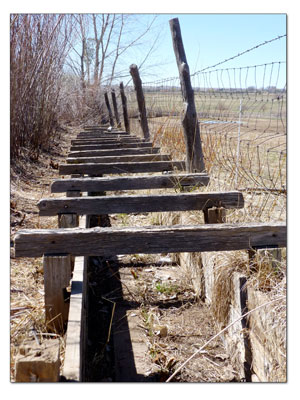
An odious to spring
For many people, the March equinox serves as the traditional seasonal marker, but not for me. When the irrigation water starts gurgling and flowing, spring has officially arrived in Montezuma County. Before MVI releases its flood, I’m always a bit frantic, like Noah trying to hammer together an Ark in preparation for the appointed day when the sky turns gunmetal gray.
There’s too much to get done. The pond needs scouring, ditches require burning, all the hoses untangled, pipe arranged, and the pumps nudged from hibernation, installed and primed, all while the tiller and the lawnmower wait in the wings like understudies to this great drama. The winter never fails to coax me toward relaxation, but then the spring rebukes me for having taken to a lifestyle of laziness.
To be fair, I should mention how the irrigation water got here in the first place. In 1886, the first ambitious Montezuma Valley irrigation project settled in for the long haul, to move Dolores River water through a tunnel to what the company hoped would become an irrigated Eden. It took three years to complete the work, and the company went bust. I can sympathize. My experience 130 years later trying to get my shares to run properly confirms that water moves along an altogether different path than money.
 I’m sure the crocuses don’t get as crazy as I do. They poke their nubile nubs up through the dirt while the sun is beating down and they prepare to stretch, like tiny yawns along the flower bed, all of them beautiful and equipped for nothing more industrious than encouraging a few insects to crawl inside their blossoms and tickle them. I hate that about the crocuses.
I’m sure the crocuses don’t get as crazy as I do. They poke their nubile nubs up through the dirt while the sun is beating down and they prepare to stretch, like tiny yawns along the flower bed, all of them beautiful and equipped for nothing more industrious than encouraging a few insects to crawl inside their blossoms and tickle them. I hate that about the crocuses.
I’m also losing a lot of respect for globe willows. Their iconic spherical shape is attributed to a self-pruning quality, which from a distance looks attractive. Aside from requiring a generous allotment of water, the trees pretend to be maintenance free.
It’s the wind that does the pruning, not the tree, and every furious spring that blows through the Southwest dumps enough kindling on my lawn to light a bonfire. Unlike those cushy piles of autumn leaves that children nostalgically leap into after their parents finish raking, for me it’s just an endless game of pick-up-sticks, dead branches falling through the canopy, littering the lawn with a latticework of writhing snakes. I keep chopping them up and hauling them off, but the wind starts to gust again, and I swear it sounds to me like a snicker.
On a clear afternoon when the wind isn’t blowing, the temperature can climb to 70. A week of this unseasonal warmth is great for sweeping the porch, picking up dead willow branches and assessing what else needs to be done. But the lilacs and the forsythia and the apricots and the plums all think it’s time to get busy, so they produce their little buds like goosebumps along their branches. Then an overnight temperature of 10 degrees freeze-dries their hopes. I haven’t seen lilacs in my yard bloom in eight years. Oh yeah, one year I ate a plum that must have survived like Superman in his Fortress of Solitude. It wasn’t exactly sweet, but I savored the pucker.
And what would spring in the Four Corners be without the odor of the newly revived and easily excitable skunks. Three-quarters of a mile from my home, traffic squashes one and the odor of its demise wafts through the neighborhood, settling inside my house. Something about my high ceilings and poor ventilation embraces the smell, like a well-used pair of shoes that retains the stink long after the owner has washed his feet and moved on.
There. I think I’ve touched on four of the five senses: the sound of the water, the pretty-as-a-picture flowers, the frigid bone-chilling overnight temps, and the smell of skunks. Need I say something about taste?
For three weeks, I worked like a brush hog rooting a path along my fence line, cutting through red willows that have created an impenetrable barrier. I snip and whip each stalk out of the way with my lopper, hoping to expose a path that will cradle 300 feet of PVC in an old flume that once served as a wooden culvert over 70 years ago. The integrity of the structure is still remarkably functional after all that time. Every day the wind blew, but sheltered by thicket I hardly felt it, only heard the willows rustling like a box of matchsticks. Each time I stepped into the open to dump a bundle I’d cut, the wind blasted me with dust. The dust stuck to my sweat, powdering my face.
Everyone who lives here knows exactly how the spring tastes.
– David Feela
